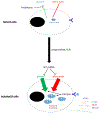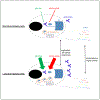Regulation of metabolic supply and demand during B cell activation and subsequent differentiation
- PMID: 30339937
- PMCID: PMC6467717
- DOI: 10.1016/j.coi.2018.10.003
Regulation of metabolic supply and demand during B cell activation and subsequent differentiation
Abstract
B cell activation and differentiation are associated with marked changes in proliferative and effector functions. Each stage of B cell differentiation thus has unique metabolic demands. New studies have provided insight on how nutrient uptake and usage by B cells are regulated by B cell receptor signals, autophagy, mammalian target of rapamycin, and transcriptional control of transporters and rate-limiting enzymes. A recurring theme is that these pathways play distinct roles ranging from survival to antibody production, depending on the B cell fate. We review recently published data that define how these pathways control metabolic flux in B cells, with a particular emphasis on genetic and in vivo evidence. We further discuss how lessons from T cells can guide future directions.
Copyright © 2018 Elsevier Ltd. All rights reserved.
Conflict of interest statement
Declaration of interests:
D.B. is a co-founder of Sana Biotechnology, Inc., and owns significant stock in Forty Seven Inc. T.E. declares no competing financial interests.
Figures



Similar articles
-
B cell conducts the lymphocyte orchestra.J Autoimmun. 2007 Mar-May;28(2-3):143-51. doi: 10.1016/j.jaut.2007.02.011. Epub 2007 Mar 23. J Autoimmun. 2007. PMID: 17363215 Review.
-
Regulation of NF-kappaB-dependent lymphocyte activation and development by paracaspase.Science. 2003 Nov 28;302(5650):1581-4. doi: 10.1126/science.1090769. Epub 2003 Oct 23. Science. 2003. PMID: 14576442
-
B cell regulation through Fc receptor-mediated signals.Contrib Microbiol Immunol. 1989;11:96-123. Contrib Microbiol Immunol. 1989. PMID: 2684513 Review. No abstract available.
-
Activation of the MEK-ERK Pathway Is Necessary but Not Sufficient for Breaking Central B Cell Tolerance.Front Immunol. 2018 Apr 9;9:707. doi: 10.3389/fimmu.2018.00707. eCollection 2018. Front Immunol. 2018. PMID: 29686680 Free PMC article.
-
Antigen Receptor Nanoclusters: Small Units with Big Functions.Trends Immunol. 2016 Oct;37(10):680-689. doi: 10.1016/j.it.2016.07.007. Epub 2016 Aug 20. Trends Immunol. 2016. PMID: 27555115 Review.
Cited by
-
Longitudinal analysis of rhesus macaque metabolome during acute SIV infection reveals disruption in broad metabolite classes.J Virol. 2025 Mar 18;99(3):e0163424. doi: 10.1128/jvi.01634-24. Epub 2025 Feb 6. J Virol. 2025. PMID: 39912635 Free PMC article.
-
IP3R-mediated Ca2+ signaling controls B cell proliferation through metabolic reprogramming.iScience. 2022 Apr 6;25(5):104209. doi: 10.1016/j.isci.2022.104209. eCollection 2022 May 20. iScience. 2022. PMID: 35494252 Free PMC article.
-
Altered Germinal-Center Metabolism in B Cells in Autoimmunity.Metabolites. 2022 Jan 5;12(1):40. doi: 10.3390/metabo12010040. Metabolites. 2022. PMID: 35050162 Free PMC article. Review.
-
TACI and endogenous APRIL in B cell maturation.Clin Immunol. 2023 Aug;253:109689. doi: 10.1016/j.clim.2023.109689. Epub 2023 Jul 6. Clin Immunol. 2023. PMID: 37422057 Free PMC article.
-
Metabolic Homeostasis of Immune Cells Modulates Cardiovascular Diseases.Research (Wash D C). 2025 Apr 23;8:0679. doi: 10.34133/research.0679. eCollection 2025. Research (Wash D C). 2025. PMID: 40270694 Free PMC article. Review.
References
Publication types
MeSH terms
Substances
Grants and funding
LinkOut - more resources
Full Text Sources

